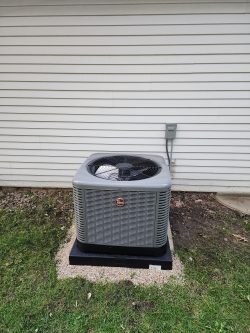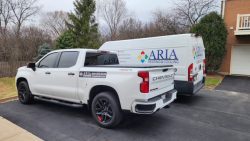Choosing Your Next Gas Furnace
Gas furnaces are an essential element in your home’s comfort level. They warm and transport heat throughout your home in cold seasons and push cooled air from a central air conditioning unit in the heat of summer. Unfortunately, it tends to be on the coldest night or hottest day of the year that your old gas furnace finally decides to give up the ghost, forcing you to call up your nearest heating, ventilating and air conditioning (HVAC) repairperson to install a new furnace immediately.
Purchasing a new furnace doesn’t have to be a knee-jerk decision. We have extensively researched and compiled information about the major manufacturers of gas furnaces on this site as a guide to help you make an educated consumer choice when buying your newest furnace.
Furnaces have evolved over the past century from wood and coal stoves to oil or natural gas burning, and manufacturers have continued to improve designs to comply with government regulations and increase their efficiency over the past few decades. This means that your overall operating costs with a newer natural gas furnace should decrease while you enjoy consistent heating throughout the chilly seasons.
Gas Furnaces: Repair or Replace?
When your furnace experiences problems or just stops working altogether, you are faced with a troublesome decision: Do you try to repair the broken part, or invest in a completely new system? The first thing to consider when faced with this question is the age of your current gas furnace. If it is older than 10 years, chances are there have been advancements in efficiency or industry standards that you can benefit from if you replace your system.
Next, consult your warranty information. Many furnace manufacturers cover the heat exchange for 10 or more years, while some have lifetime coverage. Depending on the parts that need to be replaced, your furnace might be covered by a manufacturer’s warranty. Additionally, many HVAC installers offer guarantees on their work, which can save you money if they are responsible for the problem.
Often, HVAC professionals recommend that you update or replace your existing gas furnace when you replace your central air unit. This is an excellent way to save money over time, as a high-efficiency furnace and a cooling system that are the same age and brand work together better than a mismatched-efficiency set of an older furnace and new AC unit. Unfortunately, this is not always a feasible option financially, as high-quality HVAC units can be priced in the thousands.
Ultimately, it’s up to you if you want to replace your furnace. To help you decide, consider the current efficiency of your home furnace, its age, and if you are willing to replace a part that may continue to fail in the years to come.
Gas Furnace Efficiency: It’s Not Just About the Money
Size Matters
Unlike most major appliances that get better in functionality as they increase in price and size, furnaces need to be the right size for the layout of your home. This means that buying the biggest and most energy-efficient furnace on the market is typically not the best answer for your home.
Every home is different, whether in its layout, ventilation system or materials. A natural gas furnace that is too small will not be able to produce adequate heat in the winter or push enough cool air in the summer. Conversely, a system that is too large for your home will cost more to run and not efficiently maintain correct temperatures.
Energy Efficiency
If your gas furnace was installed in your home more than 15 years ago, you are pretty much guaranteed to be heating your home inefficiently. With a high-efficiency furnace, the amount of gas you need to warm your home decreases, as do the charges on your utility statements.
When selecting the best furnace, consider the device’s annual fuel utilization efficiency (AFUE) rating. This number is represented as a percentage and indicates how much heat a furnace can obtain from each cubic foot of gas. To clarify even more, for example, an AFUE rating of 96 percent means that up to 96 cents of every dollar is used to warm your home. The national standard for lowest allowable efficiency is 78 percent, and many modern units achieve upward of 98 percent.
A furnace with a high AFUE rating can save you a significant amount of money in heating and electricity bills. While a unit with more than 90 percent AFUE generally costs more than one with an 80 percent rating, you’re likely to recoup any difference of cost over the furnace’s lifespan.
Another way to increase the efficiency of your new furnace is to have a compatible programmable thermostat installed along with it. Many gas furnace manufacturers have their own lines of thermostats that can push and run your furnace to its peak efficiency levels. While this is an additional cost, an updated, compatible thermostat allows you greater control over your home’s temperature and comfort levels.
What You Need to Know About Furnace Installation
A furnace is a major home-improvement investment, so any knowledge you can arm yourself with before deciding which new unit to purchase can save you time and money in the long run. Below are some key elements to forced air heating that you need to be aware of as you talk with your local HVAC professional.
Types of Gas Furnaces
Gas furnaces come in two varieties, single-stage and two-stage. Single-stage furnace blowers use a single-speed blower, which switches on and off until it reaches the desired temperature. These furnaces are usually older models, but you can still purchase one for your home that has an AFUE of 80 percent.
While these units can be a less expensive investment initially, the lower efficiency from switching on and off constantly ends up costing you more over time than a furnace with a variable-speed blower. That being said, if you have a smaller home, consult with your HVAC professional to see if a single-stage furnace would be a more viable option.
Two-stage gas furnaces operate similarly to single-stage ones, but when the temperature drops and the first stage is not producing enough heat, the second stage turns on to supplement your home’s heating needs. This second stage allows your furnace to produce and use more heat with less effort and fuel. Another great side effect of a two-stage unit is that it generally runs much quieter than the single-stage models.
Variable-Speed Fans & Modulating Valves
Variable-speed fans are an additional option to increase the efficiency of the furnace. Rather than constantly turning off and on and blowing at an unalterable speed, the variable-speed blower has the ability to slow down the motor to provide constant heat with a longer, less stressful cycle. This speed control allows the furnace to use less gas and to operate much more quietly, a great bonus for heating large homes or awkward floor plans. Generally, two-stage furnaces are equipped with variable-speed fans, helping them run even more efficiently than they would with a standard, single-speed blower.
Some furnaces are equipped with a special modulating gas valve. This specialty component works in tandem with a variable-speed blower to provide consistent temperatures. This is much like driving an automobile on a freeway at a constant pace, rather than stopping and starting at every stoplight downtown. Modulating furnaces can reach an AFUE of up to 98 percent. While they cost more to purchase, these furnaces maximize your comfort levels and can greatly reduce your overall energy costs.
Lennox
Dave Lennox built the world’s first riveted-steel furnace in 1890, and because of his pioneering efforts, the Lennox company has continued to develop gas furnaces focused on efficiently heating your home. The Dave Lennox Signature Collection offers the finest furnaces Lennox has to offer homeowners, including the SLP98V, a modulating gas furnace with the highest achievable AFUE to date – up to 98.7 percent. Lennox’s other quality furnaces, such as the EL196V and the ML195, are part of the Elite and Merit series and provide affordable heating solutions. Discover more information about Lennox gas furnaces and what makes its models worth installing.
Call ARIA Heating & Cooling for a free estimate, we will answer any other questions that might arise in our in-home consultation.
Service Area Includes:
Chicago, IL / Addison, IL 60101 / Bloomingdale, IL 60108 / Broadview, IL 60155 / Brookfield, IL 60513 / Burr Ridge, IL 60527 / Darien, IL 60561 / Downers Grove, IL 60515 / Downers Grove, IL 60516 / Elmhurst, IL 60126 / Franklin Park, IL 60131 / Hillside, IL 60162 / Hinsdale, IL 60521 / Itasca, IL 60143 / La Grange, IL 60525 / La Grange Park, IL 60526 / Lombard, IL 60148 / Lyons, IL 60534 / Medinah, IL 60157 / Melrose Park, IL 60160 / North Riverside, IL 60546 / Northlake, IL 60164 / Oak Brook, IL 60523 / Oak Park, IL 60301 / Oak Park, IL 60302 / Oak Park, IL 60304 / River Forest, IL 60305 / River Grove, IL 60171 / Riverside, IL 60546 / Roselle, IL 60172 / Schiller Park, IL 60176 / Stone Park, IL 60165 / Villa Park, IL 60181 / Westchester, IL 60154 / Western Springs, IL 60558 / Westmont, IL 60559 / Willowbrook, IL 60527 / Wood Dale, IL 60191 / Des Plaines, IL 60018 / Elk Grove Village, IL 60007 / Hoffman Estates, IL 60169 / Schaumburg, IL 60173 / Schaumburg, IL 60192 / Schaumburg, IL 60193 / Schaumburg, IL 60194 / Schaumburg, IL 60195 / Streamwood, IL 60107 / Barrington, IL 60010 / Bartlett, IL 60103 / Batavia, IL 60510 / St. Charles, IL 60174 / St. Charles, IL 60175 / Warrenville, IL 60555 / Wayne, IL 60184 / West Chicago, IL 60185 / Wheaton, IL 60187 / Wheaton, IL 60189 / Winfield, IL 60190 / Woodridge, IL 60517 / Carol Stream, IL 60188 / Geneva, IL 60134 / Glen Ellyn, IL 60137 / Glendale Heights, IL 60139 / Hanover Park, IL 60133 / Lisle, IL 60532 / Naperville, IL 60540 / Naperville, IL 60563 / Naperville, IL 60564 / Naperville, IL 60565.




